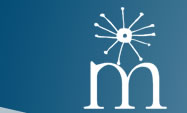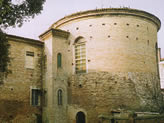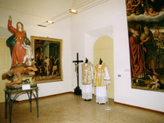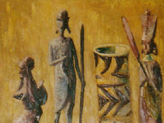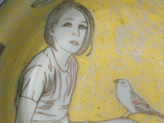Museo Civico - Russi
Rocca del Castello, Via Don Minzoni 48026 Russi
Tel. 0544 587641 Fax 0544 582237
email cultura@comune.russi.ra.it
web http://www.comune.russi.ra.it/La-Citta/Musei-e-monumenti/Musei2/Museo-Civico
Apertura: sabato ore 9-12
È possibile visitare il Museo anche su appuntamento telefonando all'Ufficio Cultura del Comune al n. 0544 587641 o alla Pro Loco di Russi al n. 0544 587670
Ingresso gratuito
Accessibile ai diversamente abili
A partire dal 1997 il Museo si articola in tre sezioni distinte: la Pinacoteca, il Museo Archeologico e il Fondo Alfredo Baccarini.
La Pinacoteca ospita sia la raccolta di opere d'arte a tema religioso di proprietà dell'Azienda Unità Sanitaria Locale di Ravenna, sia l'eterogenea collezione civica di opere d'arte; le opere esposte sono prevalentemente dipinti provenienti da diversi luoghi del territorio provinciale e coprono un arco temporale che va dalla fine del Duecento al nostro secolo.
Il Museo Archeologico - ospitato nei locali del piano terra - espone reperti rinvenuti nel complesso archeologico della Villa Romana di Russi: si tratta di una raccolta che mette in mostra sia gli ultimi reperti riportati alla luce nel 1998 durante lo scavo di un pozzo (vasi di terracotta, un orecchino d'oro, monete, brocche di bronzo e scheletri di animali) sia pezzi ritrovati negli anni '50 e rimasti chiusi fino ad oggi (mosaici, intonaci, laterizi ecc.).
Il tutto illustrato da piantine e schede informative del complesso, curate dalla Soprintendenza per i Beni Archeologici dell'Emilia Romagna in collaborazione con La Fenice Archeologia e Restauro.
Infine la Collezione Baccarini - recentemente inaugurata - presenta un'ampia scelta del fondo archivistico di Alfredo Baccarini composto da documenti, lettere, libri, medaglie, diplomi, fotografie, disegni e cimeli vari appartenuti ad Alfredo Baccarini (Russi, 1826-1890).
Ingegnere e autore di molteplici trattati tecnici, nonché deputato del Regno e poi ministro del Lavori Pubblici, Baccarini si occupò in particolare di questioni come il governo del territorio e la costruzione di infrastrutture pubbliche finalizzate a creare una moderna rete tra vie di comunicazione e aree produttive.
L'origine del Fondo oggi esposto al Museo risale al 1937, anno in cui Maria Baccarini donò al Comune di Russi la raccolta paterna; tale nucleo si è di seguito arricchito grazie al lascito di svariati documenti da parte di collezionisti privati e di parenti dello statista. Di recente tutto il patrimonio archivistico è stato accuratamente riordinato e inventariato ed è quindi a disposizione degli studiosi.
° ° ° ° ° ° ° ° ° ° ° ° ° ° °° ° ° ° ° °° ° ° °° ° ° °° ° °° ° °° °° ° ° °° °° °° ° °° °° °°° °° °°° ° ° °
The Civic Museum of Russi is located in the former hospital Maccabelli, and was built by incorporating the remains of the ancient fourteenth century fortress, of which the square plan keep and large corner tower can still be seen today.
The Museum tour consists of four different sections: the Archaeological Collection of the remains found at the Roman villa of Russi; the city rooms; the art collection belonging to the local health authority of Ravenna; the "Alfredo Baccarini" Archive Collection.
The archaeological material displayed in the antiquarium comes from the excavations of the Roman villa of Russi, one of the most representative and best conserved rustic villa of northern Italy.
The villa was probably the main building of a vast estate and the greatest development of the complex took place between the first and second centuries A.D., although there are signs of previous settlements.
The exhibition of the antiquarium runs through five rooms on the ground floor and a large round room on the upper floor.
The first room displays the objects found under the floor of the tablinium, important relics from the first period in which the villa was inhabited.
The second room shows a range of artistic objects, including the bust of Minerva and the appliqué in the shape of a small head of the god Attis. There also various coins showing the evolution of the empire and metal hinges from the doors of the owner's apartment, as well as amphoras used for the conservation of liquid in fermentation.
The third, fourth and fifth rooms display the various building materials using in the construction and decoration of the villa. In particular the room four conserves various floor mosaics: those which are semicircular in shape formed the flooring of a small pool of the frigidarium of the baths in the villa.
Finally, the room on the upper floor displays very interesting pieces from the kitchen, discovered in 1998. In fact the various layers found inside the well have revealed important information about the stages of life of the villa.
The city rooms contain the first nucleus of the civic collection of Russi, created following a desire to explore and promote a little-known local cultural heritage. Displayed in the corridor are antique watercolours maps and drawings, mainly from the municipal historic archive, constituting a graphic document of the historical transformations of the Russi Area, the historic town centre, its main building and the changing face of the city over the centuries.
The room dedicated to the nineteenth century period focuses on two key political figures of the Risorgimento and post-unification Italy from Russi: Luigi Carlo Farini and Alfredo Baccarini. Instead, the room dedicated to the twentieth century displays the works of the most important artists from Russi of the last decade: Silvio Gordini e Cino Cantimori. The favourite subjects of the first were those linked to nature, while the second carried out a passionate process of research in the themes of colours and lights.
The local health authority of Ravenna art collection consists of numerous and important works from the hospitals of the province of Ravenna. They are paintings and sculptures created over the centuries to decorate the oratories and churches of the local hospitals, giving us a valuable insight into the historic, artistic and cultural values of the community.
The Alfredo Baccarini archive collection clinches the tour of the Museum and it displays the documentation relative to the expansion and maintenance works on the Canale Corsini port in Ravenna and regarding the hydro graphic works carried out in relation to the drainage in the Maremma.
